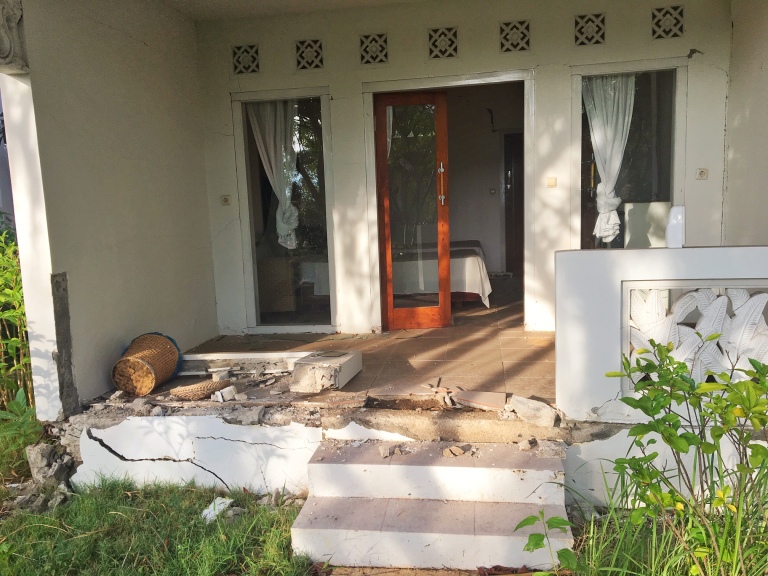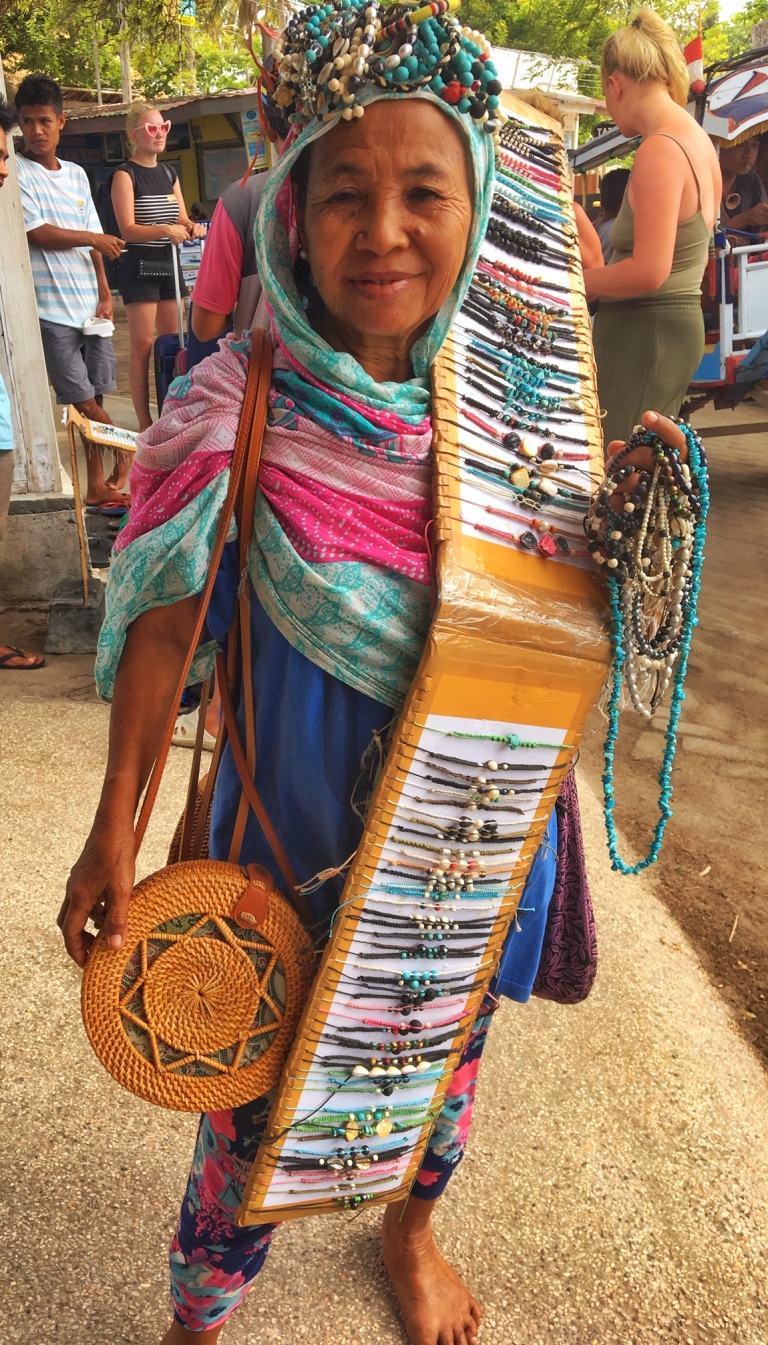
I had planned to spend the Christmas holidays in Portugal, on the eternal-spring island of Madeira. I had booked my accommodations, but I was hesitating on committing to a flight. Something didn’t feel quite right in my heart. Then one day, my newsfeed was flooded with images and stories of earthquakes and death and destruction in Lombok, Indonesia. My tiny, neighbouring island paradise of Gili Air hadn’t suffered the worst of it, but it had certainly been impacted. Things became instantly clear. I scrapped my Portugal plans and booked a flight to the first destination that ever stole my heart as a world traveller.
There is no place I have returned to more times than Gili Air, West Nusa Tenggara, Indonesia: a 15k m², sea-level island with a once-poor population sustained for centuries by fishing, but more recently thriving thanks to a massive explosion in tourism. During my first visit in 2008, a love-at-first-sight reaction had me somehow purchasing a little patch of land here. I imagined myself in a bamboo hut, living a simple life amongst these simple people during select Canadian seasons (or, more accurately, season).
Thanks to business travel that on several occasions brought me to within a more palatable distance of the island than Montreal, I managed to come back fairly regularly to check on my land and visit with my friends. But each time, the island felt different. Less calm; more spoiled. There were more travellers showing up all the time, and in turn more businesses and accommodations springing up serve them. As Wi-Fi and ATMs appeared (both of which were gloriously absent from the island in ’08-09), simplicity and authenticity seemed to fade.
It was hard to know how to feel. After all, wasn’t I part of the problem too?
By the time of my last visit in 2014, my love affair with Gili Air had lost its spark. I was glad I had never built anything on my land. Everything seemed too much. Foreigners had continued to fill fishermen’s’ pockets with cash, laying claim to most of their coconut groves and chopping down trees to build expensive villas and preposterous structures that suited their personal style, but not the island’s. Those locals who’d held onto land built anything they could, as quickly as they could. Little gaggles of local boys strumming out-of-tune acoustic guitars around beach bonfires had given way to three-day-long, drug-infused rave parties hosted by DJs flown in from Europe. Certain now-wealthy locals, who’d survived for generations off little more than fish and coconuts, had new swagger as they zipped around on electric scooters (thankfully, to this day, still no motorized vehicles permitted on the 3 Gili islands), wearing flashy sunglasses and gripping late-model smartphones. Prices were inflated and egos matched. Suddenly, everyone had money.
But it doesn’t take much to remind us of how small we are and of how little we are in control in this life, and that nature’s wrath doesn’t care how much money you have. August’s three big quakes (“The earth moved like ocean waves under my feet and I was thrown to the ground”), plus more than a thousand aftershocks, sent tourists and locals scrambling to get as far away as they could. Four months later, at what should be the peak of high season here, many locals have returned, but the tourists have not. It is so very, very quiet.
But wait — isn’t this what I wanted? No, not like this. There is a happy medium, and it doesn’t involve so much sorrow and desperation.
If there is a sliver of good that has come out of this tragedy, it is this: While devastating in ways I can’t imagine, the wrath of the quakes was an important wakeup call for the island’s inhabitants. Many businesses — concrete structures thrown together cheaply and quickly to meet growing demand — simply crumbled, and many couldn’t afford to rebuild. Those who can are rebuilding in the more expensive but far more flexible and sturdy material of wood — the way it used to be. The way it should have always been.
Businesses that survived intact have limited staff to operate them, as young workers ran post-quake to the aid of their hobbled families on Lombok. And for those who were lucky enough to survive all of that, they now have no revenue to keep them going, because there are no tourists. To quote several of my friends here, “Everyone is poor now.” Full circle.
Some believe the quakes were a clear message from Allah to remember where they came from. That shiny swagger has been ground down like sea glass, its surface worn dull, revealing deep humility and a complex mix of grief over lost lives, and gratitude for those spared. Even residents with limited English effectively use the word “traumatized” to describe their feelings about the experience. Humbleness, simplicity and respect have taken root again. I sense a shift back to life as it was when I first drifted up to the harbour in a little wooden boat ten years ago.
Past disillusionments aside, I know this is where I am supposed to be right now. The romance may have faded, but my love never will. I came out of solidarity; to inject a few dollars into their now-devastated tourism economy, to give people an outlet for their stories if they wanted one, to see if there is any small thing I can do to help. And, hopefully, to encourage other travellers to follow suit.
Indonesia is positioned along the Pacific Ring of Fire: a 40,000 km horseshoe around the Pacific Ocean that contains 75% of the world’s active and dormant volcanoes and generates 90% of the world’s earthquakes. If that frightens some into not travelling here, they should know that that same Ring also includes Chile, New Zealand, the USA, Mexico, Japan, Canada, Peru, Guatemala, Russia, and a bunch of other countries.
Crazy, scary, unexpected, uncontrollable things can and do happen everywhere in the world. We might die in an earthquake, but we might also die in a traffic accident (1.25 million deaths in 2013 alone), or get smooshed by a vending machine (13 deaths per year), or meet our maker because of a falling coconut (150 death per year —15 times more deaths than by shark attack!) or even a flying champagne cork (24 deaths annually).
Reality is, you just never know. So, just go. Explore. Travel. Take a chance. Get after it. Come back to Indonesia. Gili Air has been, and is still going through, hell, but it has learned a huge, difficult lesson. And it is still paradise, and it desperately needs you. Book a flight, pick a bungalow, name your price. Buy some touristy crap you don’t need and pay more for it than it’s worth. They need the money more than you do. Have happy hour cocktails, eat some $2 nasi goreng, take a snorkelling tour or some scuba lessons. Join me in doing anything you can to help these lovely people, with their restored value system and a newfound appreciation for life, start to get back on their feet.
It’s too damned quiet here without you.


An original and illuminating perspective on the cycle of events on the island. Thanks.
LikeLiked by 1 person
Your love of this island and the empathy for those who live there, emenates through your writing. You have followed your heart, you are where you should be for Christmas! Your “island” has beckoned you home!
Safe travels, hugs💕
LikeLike